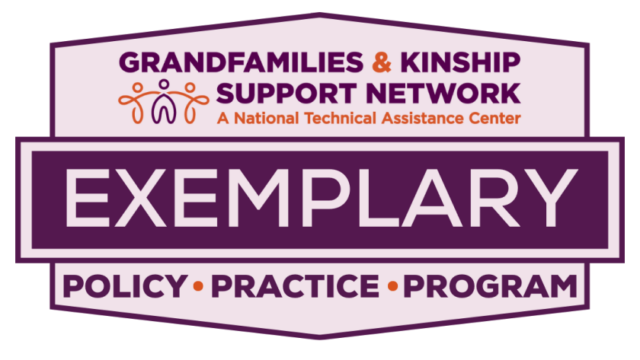Fact Sheet
HUD Section 202 Housing for Intergenerational Families: Frequently Asked Questions (FAQ)
Download This Resource
This FAQ was derived from questions asked during a January 9, 2024, webinar hosted by the Grandfamilies & Kinship Support Network, in collaboration with the US Department of Housing and Urban Development (HUD), regarding a Notice of Funding Opportunity (NOFO) for Section 202 Housing.
The NOFO was released on February 21, 2024, and includes up to $35 million in funding to develop units for intergenerational families that include a child and the child’s grandparent or other relative who is a head of the household and aged 62 or older. See the HUD NOFO webpage for additional guidance, and please note that although the website is entitled 2023, the NOFO was re-released and is active. Applications are due by July 18, 2024, at 11:59 PM ET.
How many grants does HUD plan to make?
HUD plans to make 20 awards total (for regular 202 and intergenerational units). When applying for the NOFO, applicants must indicate whether they are applying for a regular 202 award or for the $35 million available for intergenerational dwelling units. Applicants may only pick one set of funds to apply for, and if they are not awarded funds under the intergenerational dwelling units, they will not be considered for a regular 202 award.
Can one entity apply for the entire $35 million offered to intergenerational units?
No, the maximum award is $20 million.
There are many grandparents and other relative caregivers of children who are younger than age 62. Would they be eligible?
No, the statutory authority for the Section 202 Program requires the head of the household to be 62 years old or older.
Can funding be braided so some apartments are available to caregivers under age 62?
Yes, funding can be braided, but 202 Program funds may only be used for units with households headed by an adult aged 62 and over.
“HUD encourages applicants to use Capital Advance funds in combination with other non-Section 202 funding, but they may only be used in connection with units that will be assisted under the Project Rental Assistance Contracts (PRAC). PRAC units may be developed or placed within a property that also includes non-PRAC residential units (whether restricted as affordable or rented at market rates) and non-residential units (such as first floor commercial space).” This paragraph is taken verbatim from the HUD website.
Are there are “legal” custody requirements to identify the grandfamily?
No, the Section 202 Program does not define the meaning of “custody.” Any applicable state or local requirements regarding the custody of a child would govern.
Is there a maximum age that a child can live in this setting?
For intergenerational dwelling units, a child is defined as someone up to 19 years of age, if in school part-time or full-time, and up to age 18 if not in school. Occupancy in Section 202 housing is open to any very low-income household comprised of at least one person who is at least 62 years old at the time of initial occupancy. Once the child becomes an adult, any income they may earn counts as earned income, which may result in the household becoming over income.
Do the older adults have to move from the intergenerational dwelling unit once the children are over 18?
The intergenerational units may be part of a larger Section 202-funded building. In this case, the housing provider may move the grandparents or other relative caregivers to an appropriately sized unit once the children have moved out. If the units are not within a larger 202 building, then the housing provider may help the grandparents or other relative caregivers establish a timeline and help them find another suitable housing location.
If a family with one grandparent and two grandchildren moves into a two-bedroom apartment in a HUD-funded intergenerational project and the grand-children move out when they “age-out,” is the grandparent allowed to stay on as a single person in a two-bedroom unit? Or would they be seen as “over-housed”?
Like in other HUD-funded housing, when the family size changes, the household must move to a unit with the appropriate number of bedrooms, once an appropriate-sized unit is available.
Is there any assistance for grandparents or other relative caregivers living with a child who has a disability and is over age 18?
The LEGACY – Living Equitably: Grandparents Aiding Children and Youth – Act of 2003 is the first federal law to create affordable housing opportunities for grandfamilies. That law authorizes intergenerational dwelling units for families comprised of at least one elderly person and one child. The Act defines a child as someone up to 19 years of age, if in school, and up to age 18 if not in school. The Section 811 Capital Advance and the Section 811 PRA Programs serve individuals who are over age 18 and living with a disability.
We provide housing to grandfamilies in the form of rental assistance. Does that count as prior experience for this NOFO? We don’t operate any housing facilities.
Yes, providing housing to grandfamilies in the form of rental assistance demonstrates prior experience. Please see the NOFO for specific details about experience.
To what do you attribute the extremely low application rate for the 2022 NOFO and why were there no awards for intergenerational units?
HUD believes that, for many Section 202 developers, the intergenerational component was new, and they did not know how to integrate those units. HUD is working hard to get the word out during this round so that more applicants will include intergenerational units in their proposals. There were no awards made for intergenerational units in the last round because the applicants were either ineligible or the proposed project did not score high enough to be funded.
Is there an available list of the six applicants that applied for intergenerational units in the prior NOFO?
Applicant information is not publicly available; however, you may submit a Freedom of Information Act request to FOIA@hud.gov.
Is HUD accepting applicants from communities across the US?
Yes.
Is the funding also available to territories?
Yes, if the applicant meets the eligibility criteria.
Is funding available to federally recognized tribes?
Yes, if the applicant meets the eligibility criteria.
How do you recommend that a housing developer gain experience with building these communities, as that seems to be a requirement on which an applicant is scored?
If the developer does not have experience, they can partner with an organization that has experience working with families led by grandparents or other non-parent relatives.
Is there a list of successful Section 202 developers available?
HUD has a list of previous Section 202 awardees available on its website.
Are there Section 202 funding restrictions on historical building acquisition and development for grandfamily housing?
There are no Section 202 restrictions, but the project must meet the requirements of the NOFO. The project must also meet any local requirements: zoning, environmental, etc.
What is the minimum number of intergenerational units for a project to be eligible for funding?
To be eligible for the intergenerational set-aside funding, the higher of five (5) units or 20% of all Project Rental Assistance Contract (PRAC) units must be designated as intergenerational units in the proposal. The proposed intergenerational units are included in the count of all PRAC units. For example, if an applicant is proposing 50 non-intergenerational PRAC units, they would need to include at least 13 intergenerational units (13/63 units) to meet the 20% threshold.
Is service coordination needed for the children and older adults?
No, applicants do not need separate service coordinators to support children and older adults. Those applying for the intergenerational units will be asked to describe the services that will be provided to older adults and children in their proposals.
What is “site control”?
The term “site control” refers to the legal right to acquire or lease a site/property. There are several potential ways that one can demonstrate site control. Please see the NOFO for a complete description of required documentation.


